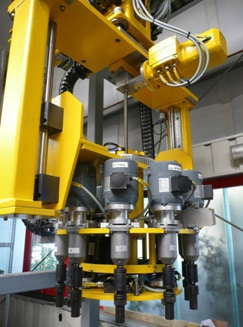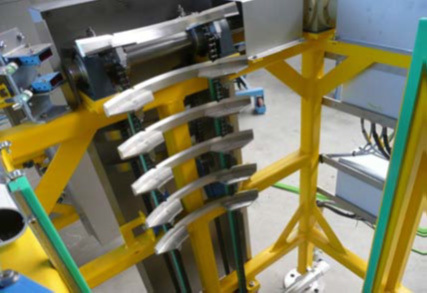Drums that use a waste package with an elevated dose rate need to be capped automatically to avoid a dose rate exposure of workers.
A Westinghouse-design drum capping system provides fully-automatic drum lid storage and fully-automatic capping of waste drums. The system can be installed in buildings, as part of a larger facility, and also in mobile systems.

Capping machine
The drum capping system is designed for fully-automatic capping and uncapping of waste drums. After a drum is opened, the lid with screws is stored in the lid magazine. Usually, the drum is opened before filling or grouting and capped after grouting (or any other conditioning activity).
Closed, empty drums are loaded onto the drum transport system and are transferred automatically to the uncapping position (e.g., by roller conveyors). The capping machine with 10 screwdrivers is positioned above the closed waste drum.
The capping machine is lowered and the drum lid is attached to the capping machine. The screwdrivers unscrew the lid from the drum and the capping machine is pulled up with the attached lid. The uncapped drum can then be transported to its designated process position and the lid is stored in the lid magazine. The same procedure is applied vice versa to close/cap a filled waste drum.
The lid magazine is designed to store drum lids while the drum is in another processing system. The lid magazine is charged with a lid by means of the capping machine when a drum is uncapped. Lids with the integrated screws are stored in each lid magazine. An elevator moves the lid to be handled into the upper position. There, the capping machine receives and removes the lid. Inductive proximity switches and light barriers control the position of the elevator to ensure the lid is properly placed in the top position.
In case filter cartridges have to be treated, the lids are stored in a separate lid magazine and must be attached to their related drum to avoid cross-contamination.

Lid magazine
Drum capping offers the following benefits:
Westinghouse experience with drum capping systems dates back to 1997 in Switzerland and to 1999 in Germany. Drum capping is a widely accepted practice where dose reduction strategies are critical to operational requirements. By using this equipment, the drums can be loaded into a fully automatic waste treatment process without the need for manual interference. The necessary throughput of waste treatment systems and the logical process flow can then occur.
More recently, Westinghouse has provided systems and components to six nuclear power plant sites in China as part of cementation and site radwaste treatment facilities.